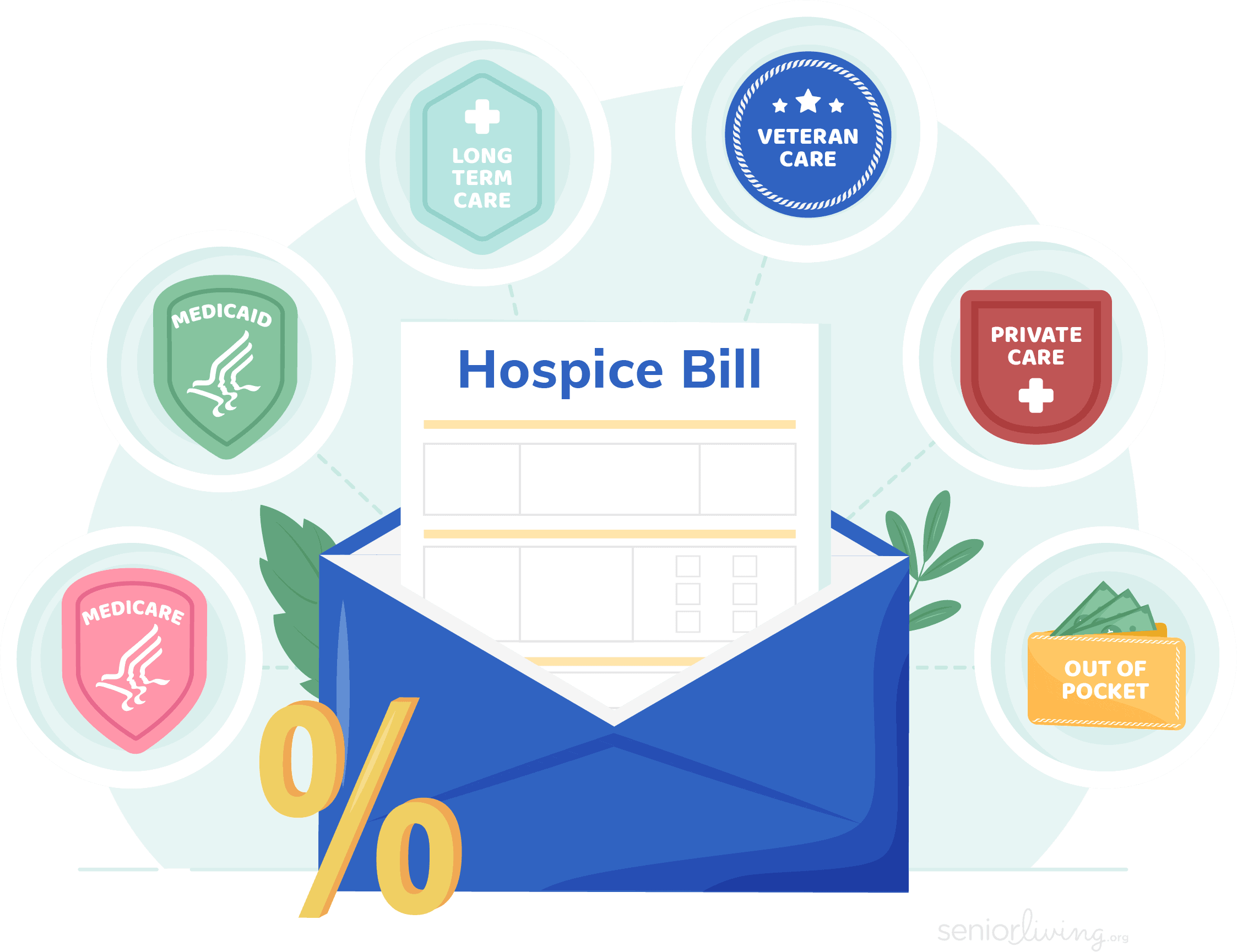How Much Does Hospice Care Cost?
Medicare often covers hospice care. Recipients may not have to pay out of pocket for most of the costs.
SeniorLiving.org is supported by commissions from providers listed on our site. Read our Editorial Guidelines
Get Quotes for Hospice Care Near You
Join 16,943 Families Who've Found Home Care Options on SeniorLiving.org.
Get Quotes for Hospice Care Near You
Planning for and managing end-of-life care can be overwhelming for caregivers in terms of not only the emotional stress but also the potential financial stress. Understanding the costs associated with end-of-life care, also called hospice care or comfort care, can help relieve some of that stress. With the correct knowledge, you can help prepare your loved one should they need hospice care one day. Below, we’ll explore how much you can expect to spend on hospice care and the many ways to pay for it.
How Much Does Hospice Care Cost?

How much does hospice cost?
Compared to other forms of care, hospice care falls on the less expensive side for patients. Why? For Medicare and other insurers, it’s cheaper to pay for hospice care services than it is to pay for ongoing treatments.1 That’s why many insurers offer full coverage for hospice services.
The easiest way to assess hospice care costs is to examine what Medicare pays for services. The chart below shows the price Medicare paid in 2021 for the four levels of hospice care services.2 Remember, this is what Medicare pays a provider, not what you owe out of pocket.
| Level of hospice care | Type of care | What is it? | Daily payment rate |
|---|---|---|---|
| 1 | Routine home care (Days 1 to 60) | Routine hospice care services in your home, assisted living facility, or nursing home | $211.34 |
| 1 | Routine home care (Days 61+) | Routine hospice care services in your home, assisted living facility, or nursing home | $167.00 |
| 2 | Continuous home care | Hospice care in your place of residence that consists mainly of nursing care continuously | $1,522.04 |
| 3 | Inpatient respite care | Hospice care for up to five days at a time in a respite care facility, like a nursing home or hospital, to give your primary caregiver a rest | $492.10* |
| 4 | General inpatient care | Hospice care in an inpatient facility for pain control or symptom management that isn’t available in another setting | $1,110.76 |
* You may owe 5 percent of inpatient respite care costs. For example, if your stay costs $100, Medicare may pay $95, and you may owe $5. To learn more, read our guide to respite care costs.
Those daily rates may look steep, but most older adults pay nothing for hospice care.3 Yes, you read that right! Most hospice users pay nothing out of pocket. Medicare or Medicaid cover the costs.
Our free housing and care finder uses your unique needs to curate a list of the best options in your area.
How Much Does Hospice Care Cost Per Day?
The cost of hospice care depends on many factors. We can provide only a ballpark figure for the daily expenses. One hospice center we found estimates that hospice care costs $150 daily for home care and $500 daily for inpatient care.4 This lines up with what we see Medicare paying hospice care providers.
Of course, what you’ll owe per day for hospice care depends on the following factors:
- Level of care
- Insurance
- Income level
- Age
- Qualification criteria
- State of residence
- Whether care is delivered at home or in a facility
- How long hospice services are needed
Pro Tip: To get a more accurate idea of daily hospice costs in your area, talk with local providers about pricing, which types of insurance they accept, and if there are any payment plans or charitable funds available.

SeniorLiving.org is supported by commissions from providers listed on our site. Read our Editorial Guidelines
How to Pay for Hospice Care

How to pay for hospice care
Now we’ve seen the expenses. Let’s explore common ways to pay for hospice care, including Medicare and Medicaid.
Medicare
Most seniors use Medicare benefits to cover the cost of hospice care. An estimated 85.4 percent of hospice costs each year are paid for by Medicare.
What Will Medicare Cover?
Medicare offers generous hospice benefits covering supplies and services related to pain or disease severity reduction and terminal illness. They provide two 90-day periods of hospice care, followed by unlimited 60-day periods of care. A doctor must recertify that you have less than six months to live after each care period.5
Coverage includes:
- Hospice services from a physician or nurse practitioner
- Nursing care
- Medical supplies
- Medical equipment
- Drugs for pain and symptom management
- Hospice aide and homemaker services
- Physical and occupational therapy
- Speech-language pathology services
- Medical social services
- Dietary counseling
- Spiritual counseling
- Grief and loss counseling for individual and/or family before and after patient’s death
- Short-term inpatient pain control and symptom management
- Short-term respite care
What Won’t Medicare Cover?
When you decide to use Medicare for hospice care, you’re giving up your right to use Medicare to cover other services relating to terminal illness.
Medicare won’t cover:
- Life-saving medical treatments aimed at curing your terminal illness
- Room and board, such as in a nursing home or hospice facility
- Prescription medications intended to cure the terminal illness
- Hospice care outside of your designated hospice provider
- Inpatient or outpatient hospital care, unless it’s unrelated to your terminal illness or is scheduled by your hospice team
- Ambulance transportation, unless it’s unrelated to your terminal illness or is scheduled by your hospice team
Did You Know? Medicare doesn’t fully cover prescriptions, even when you’re in hospice. You owe a copay of up to $5 per prescription for pain and symptom management. Ask your hospice team if your Medicaid or Medicare Part D plan will cover the full cost of the prescription.
How to Qualify
Patients with Medicare Part A must meet the following criteria to qualify for hospice care benefits:6
- Be 65 years of age or older
- Use a Medicare-certified hospice
- Attending physician and hospice physician certify that they are terminally ill, with a prognosis of six months or less to live
- Agree to forgo potential life-saving or curative treatments for their terminal illness by signing an election statement
Medicaid
States can choose whether or not to provide Medicaid-covered hospice care. Look up your plan or visit your state’s Medicaid website to see what your state offers.
What Will Medicaid Cover?
If a state Medicaid program wants to cover hospice benefits, it must meet federal regulations for standard care, including:7
- A minimum of 210 days of coverage
- Nursing care
- Medical social services
- Physician services
- Counseling services for the patient and their family members
- Short-term inpatient care
- Medical appliances and supplies
- Home health aide and homemaker services
- Physical therapy, occupational therapy, and speech-language pathology services
FYI: Medicare and Medicaid both cover grief counseling services for caregivers. These services can help you process your grief before and after your loved one passes.
How to Qualify
You must meet Medicaid qualifications and the requirements for Medicaid’s hospice benefits. These requirements vary between states but most commonly include:
- Having a hospice plan of care
- Being certified terminally ill by a hospice care physician
- Electing the hospice benefit by signing an election statement with the hospice care provider
- Choosing a specific hospice provider
- Waiving Medicaid services intended to cure the terminal condition
It’s up to states to determine when they’ll start covering hospice care. For example, in Texas, Medicaid follows the same six-months-or-less life expectancy criteria as
Long-Term Care Insurance
The facility cost is typically not covered by Medicare or private medical insurance if your loved one needs to receive hospice care while staying in an assisted living facility or nursing home. That’s why some families turn to long-term care insurance.
What Will Long-Term Care Insurance Cover?
Long-term care (LTC) insurance companies typically cover 100 percent of average long-term care services. It includes everything from hospice care at home to a stay in a hospice facility to your nursing home room and board costs while you receive hospice care services through Medicare.
How to Qualify
Specific qualification criteria will vary between LTC insurance providers. If you already have an LTC insurance plan, speak with your provider about when you’re eligible to start receiving hospice care. If you don’t have a plan yet, just know that some companies won’t let you purchase plans if you’re already in poor health or receiving long-term care.
Veteran Health Care
Veterans can receive hospice care for free (no copays) through the VA. You must be enrolled in the VA’s healthcare system to receive benefits. To be eligible, you must have a terminal condition with less than six months to live, and you must stop seeking treatment for that terminal condition. VA hospice care includes services like symptom and pain management as well as bereavement support for your family.
Private Health Insurance
Most private health insurance companies cover hospice care to some degree. The exact coverage will depend on your insurer and your plan. Call your provider or visit their website to learn about your specific hospice care benefits.
Paying Out of Pocket
Some families must pay out of pocket for hospice care. It can include someone 62 years or older taking out a reverse mortgage or family members tapping into savings – both of which can be costly.
Fortunately, many hospice care providers are nonprofits that may let families pay on a sliding scale. Others may have donations or grant money set aside to help families cover the complete cost of hospice care. If you’re unable to pay for hospice care with other means, talk with local hospice care providers about how they can help lower the financial burden.
U.S. News. (2018). The Costs of Entering Hospice Care.
Centers for Medicare & Medicaid Services Medicare Learning Network. (2024). Update to Hospice Payment Rates, Hospice Cap, Hospice Wage Index and Hospice Pricer for FY 2023.
Medicare.gov. (2021). Hospice care.
Auburn Crest Hospice. (2017). How Much Does Hospice Care Cost?
Centers for Medicare & Medicaid Services. (2021). Hospice.
Medicaid.gov. (2021). Hospice Benefits.
Texas Health and Human Services. (2021). Hospice Care.

